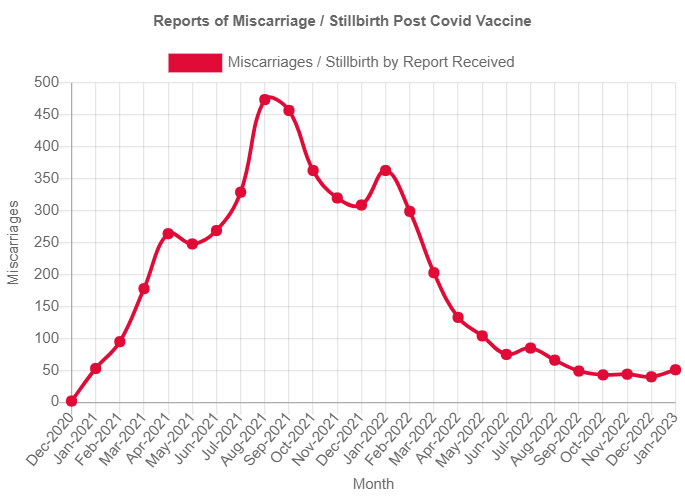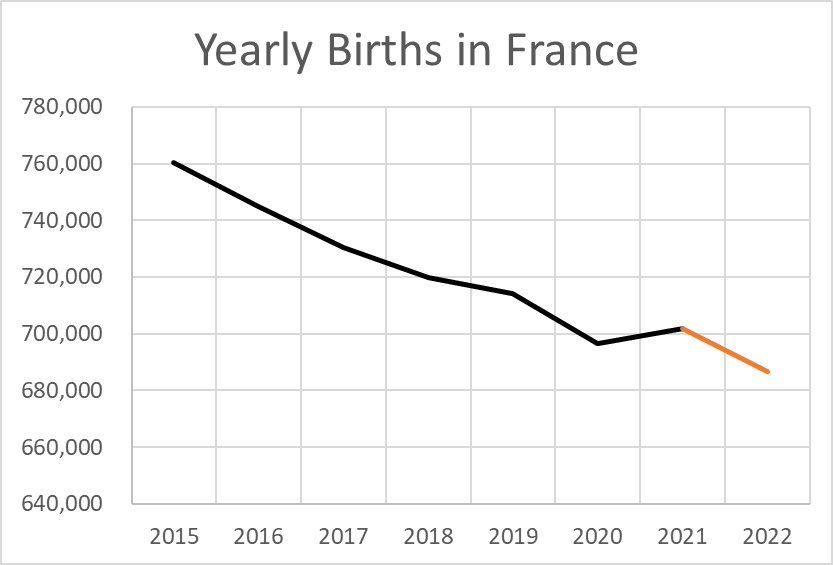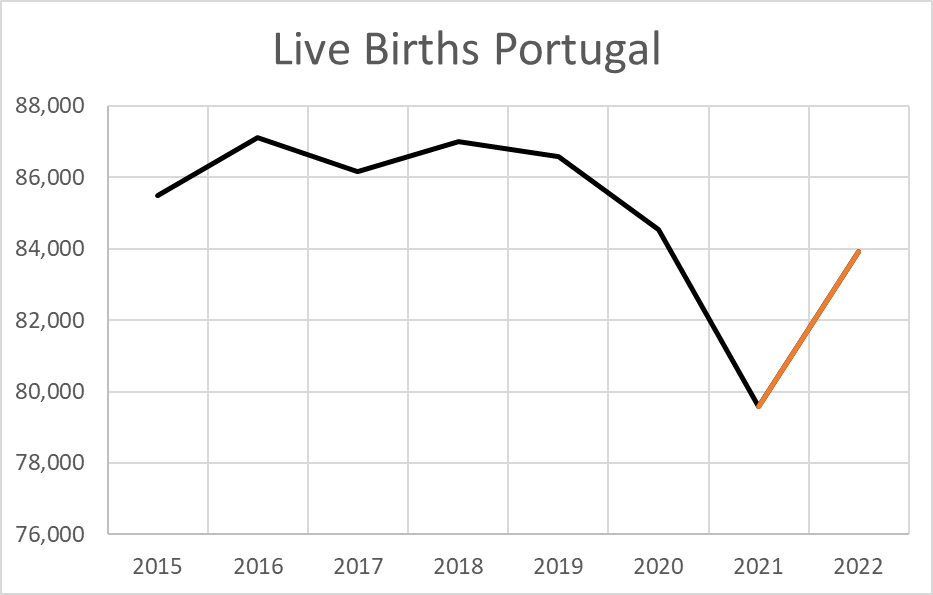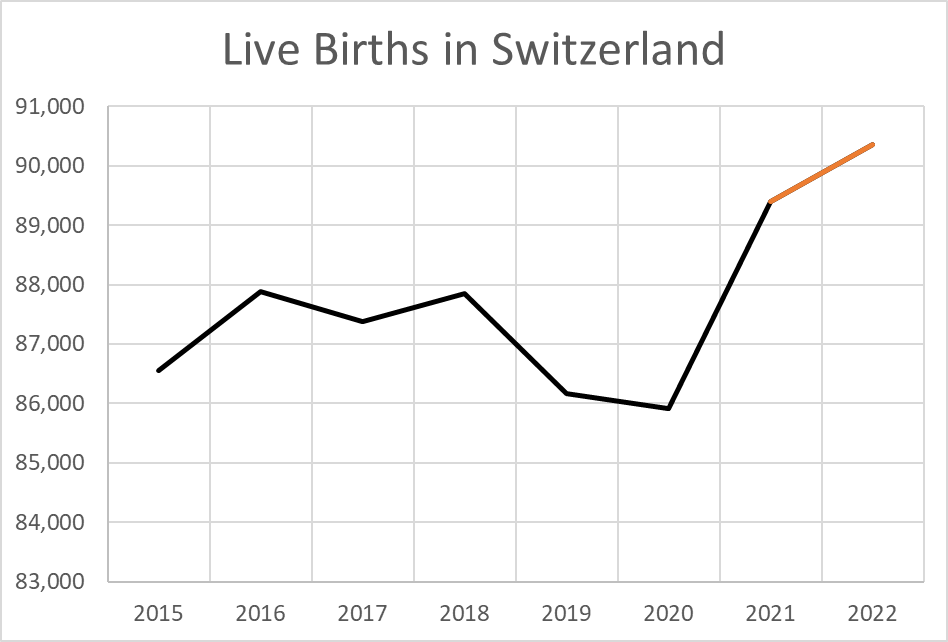From the beginning, there have been glaring signs that the mRNA shots may be impairing fertility. FDA overrode signals that, in years past, would have been considered unacceptable dangers. After majorities of the reproductive-age population were inoculated, many of us expected to see sharp declines in birth rates beginning nine months later. Preliminary data suggests that our worst fears have not materialized. The reason for this is not yet clear.
Warning signs in flashing neon
In the spring of 2021, early signs suggested that COVID shots might cause a steep decline in fertility. The April New England Journal article that was supposed to reassure us that the vaccines were safe for pregnant women actually included data tables that one researcher interpreted as an 80% miscarriage rate for women vaccinated in their first trimester. A follow-up article was based on a sample skewed heavily toward women vaccinated later in their pregnancy, when miscarriage risk is mostly past. Japan released Pfizer animal data (also available to the West, but kept from the public) indicating that lipid nanoparticles from the vaccines tend to accumulate in the ovaries. And among the few pregnant women who slipped inadvertently into the Pfizer trial, the rate of stillbirths was high.
The mRNA shots were recommended in 2021 for pregnant women all over the world, even though pregnant women were excluded from clinical trials the previous fall. After the fact, Pfizer initiated a trial specifically for pregnant women, then abruptly curtailed it and never issued a report. Maryanne Demasi reported recently on this apparent cover-up.
If our governments were honestly interested in vaccine safety, they would have been carefully monitoring fertility among many other health measures, with separate categories for vaccination status, number and timing of doses in both the mother and father. But this data has not been collected, or (more likely) it has been collected (by VSafe) but not shared with the public. One article based on the authors’ proprietary access to VSafe indicated moderately elevated levels of miscarriage in the late first trimester, and omitted pointedly to report on data from the first six weeks of pregnancy.
Last year, the German Federal Institute for Population Research issued a preliminary analysis noting sharp drops in fertility in early 2022. Women of child-rearing age began being vaccinated in the second quarter of 2021, so if there were an effect on fertility, we might expect to see it beginning 9 months later in the beginning of 2022.
“in the immediate aftermath of the pandemic, monthly fertility data from Sweden and Germany show a strong fertility decline in early 2022, with about 10 to 15 % less births, respectively, than what was observed during the same period the previous year. This poses questions on the role of previously suggested mechanisms for pandemic-related fertility change, such as the role of health-related or economic-centred factors in recent fertility change. It also brings factors related to the perceived cessation of the pandemic to our attention, as reflected in the onset of broad-based vaccination programmes directed at the population at reproductive and economically active ages.”
The German report was recently cited in a Substack by James Lyons-Weiller.
Some more reasons for concern:
Graph from OpenVaers.com
VAERS reports of miscarriages skyrocketed after the COVID vaccines were introduced in 2021
Bill Gates and his family have been associated with population control, and the Catholic Church had outed the Gates Foundation’s tetanus vaccine in Kenya as a stealth birth control treatment [WaPo]. There is speculation that the vaccines may have been designed to bring down world population.
Dr James Thorp, a Florida Ob-Gyn, has been talking about this, and he has written a journal article that's scheduled to be published next week.
Naomi Wolf has been writing about effects of COVID vaccines on fertility, including sperm viability in men.
Dr Arne Burkhardt has also studied damage to male fertility..
An article this past week in Epoch Times summarized reasons to think that COVID shots re causing a substantial decline in fertility. The article featured a pan European report (anonymous, attributed to Raimond Hagemann, Ulf Lorré, and Dr. Hans-Joachim Kremer) issued last summer. The authors analyzed birth data from 23 European countries and found a decrease by several percent in live births beginning in the first quarter of 2022, nine months after the mRNA shots were introduced to people of child-bearing age in Europe.
What do the 2022 data say?
Last year’s pan-European report included data only for the first half of 2022. I have followed the sources in their bibliography and searched elsewhere online for European birth counts in the second half of 2022. What I have found is evidence that Germany and Sweden had birth counts in 2022 that were about 8% below historic expectations, but in other major European countries, the evidence was ambiguous. Polish births in 2022 were down more than expected. France, Norway, Portugal, and Italy reported 2022 birth counts more or less in line with recent historic trends. In Switzerland, Austria, and Spain, birth counts in 2022 were actually above historic expectations. Data from UK, Canada, and US were conspicuously absent.
(“Adjusted for length of month” means that I smoothed over months with 28, 30, or 31 days by pro-rating each to one twelfth of a year.)
Here are data from Germany. The “Expected” line is based on a weighted average of the previous three years. 2021 is a little higher than expected. Notice that between December, 2021 and January, 2022, births drop by about 8%. The birth rate remains below the expected line through October, the last month for which data is published. The birth deficit does not grow through the year 2022, even though more and more young women were vaccinated through 2021.
It is impossible to draw firm conclusions from this, but it is consistent with a prompt effect of vaccination on fertility which does not accumulate over time. In other words, from this very limited data, the suggestion is that vaccination is causing miscarriages or otherwise depressing fertility immediately, but that women are recovering their fertility after the effect wears off. (This is not a conclusion, but a speculative inference based on limited data.)
Here are data for Sweden, which are roughly comparable. Births are down 8% year over year.
Both Germany and Sweden bucked the trend in the Western world toward declining birthrates in recent years. The “expected” line in the graphs above is based on an average of previous years, not a trend.
We don’t yet have confirmed data for other countries, and if we did, it would be harder to interpret because there is uncertainty in the downward trend. I have looked at “provisional” data from other European countries and the state of California.
California births have been on a decade-long decline, and in addition, the state lost population during the pandemic; so the “expected” numbers are low. Birth counts in 2021 were higher than expected, and in 2022 (provisional data) they were almost as high.
France is typical of the American states and the EU in that birthrates there have been declining during the last decade. Calculating the “expected” line must include a trend, adding to uncertainty. In the provisional data for France, births dipped in the first year of COVID and there was a rebound in 2021. 2022 births reverted toward the downward trend of recent years, but there is no indication of a further, unexpected decline..
Poland: Birth counts were steady or increasing in the first years of this century, but declined steadily after 2016. The rate of decline averaged 4% from 2016 to 2021, and jumped to 8% in 2022.
Portugal: The pan-European Report noted a decline in January-February 2022 compared to the trend in previous years, but the deficit was made up later in the year and births for the full year were 4.8% above 2021, almost as high as 2020, 3.7% lower than 2019.
Spain: Births in Spain have been in a multi-year decline, but 2022 increased over 2021 for the first time since 2008.
Norway: After a decade-long downward trend, births were way up in 2021, and then 2022 declined steeply, but arguably in line with the long-term trend.
Italy: There was a noticeable drop in births for the first quarter of 2022 compared to previous years, but later numbers (reported through November) seem to have recouped the deficit. Births in Italy have been on a long-term decline of about 3% per year, a little steeper than in most European countries. Preliminary numbers for 2022 seem to be in line with that trend.
Switzerland: Birth counts in Switzerland are not historically decreasing. Births were up sharply in 2021 compared to 2020, and up a further 1% in 2022.
Austria: Births have been declining since 2016. There was a small drop in 2020, a steep increase in 2021, and 2022 births are almost as high as 2021.
Correlations in space and time
All the above graphs and stories are based on correlations in time: Did birth rates decline nine months after the wave of inoculation in people of childbearing age? The pan European report also included another way to look at the question: Did countries with higher vaccination rates suffer greater declines in fertility? From data in this report, I did my own calculation (not included in the report text). I found that declines in fertility during the first half of 2022 were correlated with the percentage of vaccination in each country (r=0.37), but there was a lot of scatter in the data and the correlation would not be considered statistically significant (p=0.12).
The Bottom Line
There are substantial reasons to think that the mRNA shots are affecting fertility, referenced in the first part of this article. These come from animal studies, human studies, and biochemical reasoning. Post-marketing reports from VAERS indicate an effect on fertility unprecedented in any past vaccine. Then, a report last summer based on 23 European countries in the first half of 2022 found a pattern of low birth rates overall, about 4 or 5 percent below expectation (my estimate).
These trends were already rather mild compared to draconian expectations from the trials and the Pfizer cover-up. And if anything, the effect seems to have been even less severe in the second half of 2022. Germany, Sweden, and Poland were the only countries in which there was clear evidence of a birth deficit.
Possible explanations:
Maybe the risk of miscarriage from the mRNA shots is smaller than indicated in the Pfizer FDA submission and in the VAERS database.
Maybe the damage to fertility is short-term, and most couples recover a few months after inoculation.
Since a large majority of pregnancies carried to term are planned, maybe couples keep trying until they eventually carry a pregnancy to term, even with impaired fertility.
Maybe there is a concerted, international conspiracy to overcount births in official documents.
All these factors may be contributing to the departure from expectation. Just last week, a British researchers published a summary (“meta-analysis”) of 21 studies, with an aggregate finding that COVID vaccination increases the risk of miscarriage by a statistically insignificant 7%. This adds weight to the first explanation, though we may suspect that the dice were loaded in some of the 21. So I don’t discount the last possibility, because we have seen coordinated corruption of medical statistics during the pandemic. Since most of the data I have relied on here are labeled “provisional” it is possible that the numbers are based on rote projections from past years rather than actual tallies of individual records.
We may be relieved that two years after introduction of a hastily developed, heavily marketed medical product with documented effects on human reproduction, we don’t have obvious or dramatic evidence of a drop in birth rates among highly-vaccinated nations. But this is not a reason to give a pass to the mRNA shots. In the context of historically accepted standards of medical safety, even a one or two percent risk of impaired fertility would be enough to pull any product from the market. In evaluating the risks and benefits of the mRNA shots, our FDA and other organizations around the world have made a sharp break from past practices, applying an entirely different standard. Along with other researchers, I have called for open data, transparent methodologies, and a return to honest and independent evaluation of medical products.
Data sources
Austria Austria
California California California
France
Germany Germany
Norway
Poland Poland
Portugal Portugal
Italy Italy
Spain
Sweden
Switzerland Switzerland
















Not a “science-based” comment, and admittedly not a data researcher, but wouldn’t the imposed isolation and lockdowns have increased the “intimacy opportunities” for couples, and to a degree potentially skewed the data of 2020-22 compared to the past decades as more folks were perhaps (intentionally or not) becoming pregnant?
My reading of the tea leaves is that the mal-effects of this poison are proximal to the jab. Things return close to baseline as time passes.